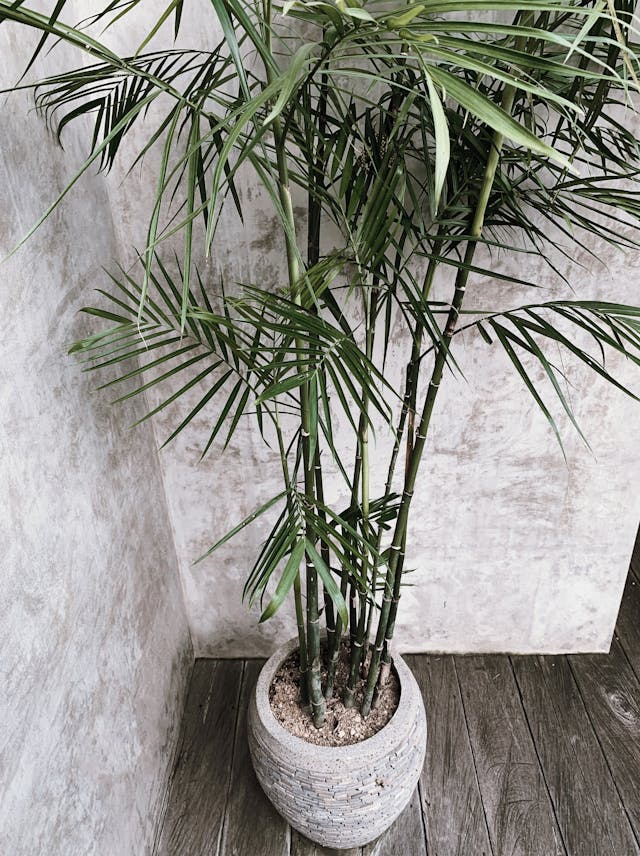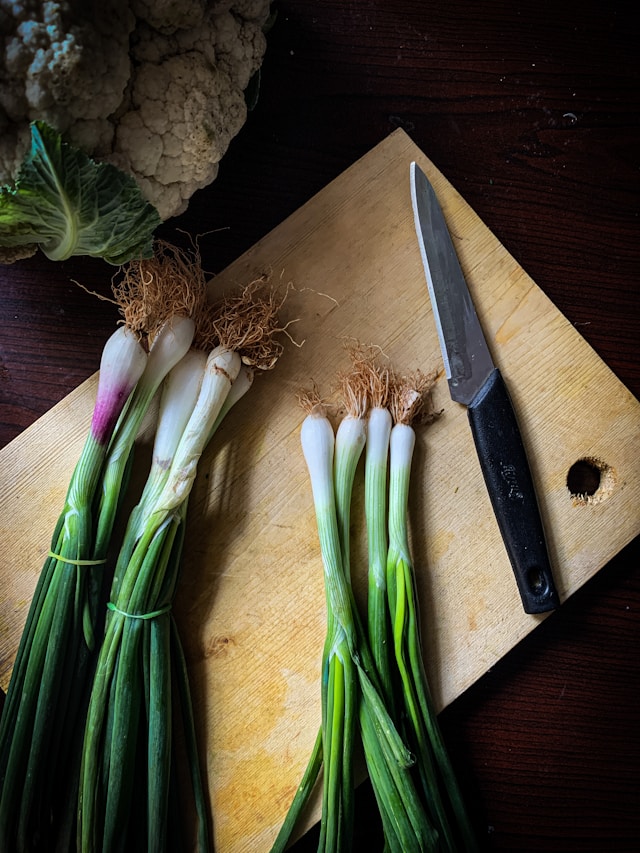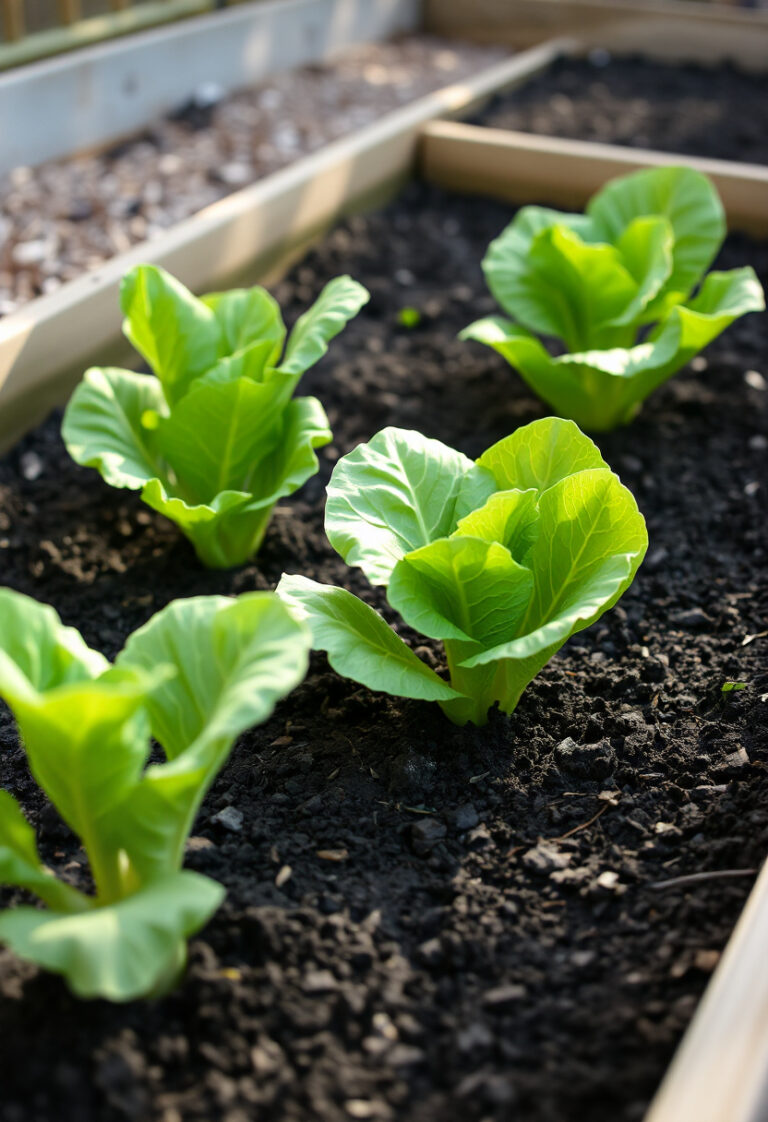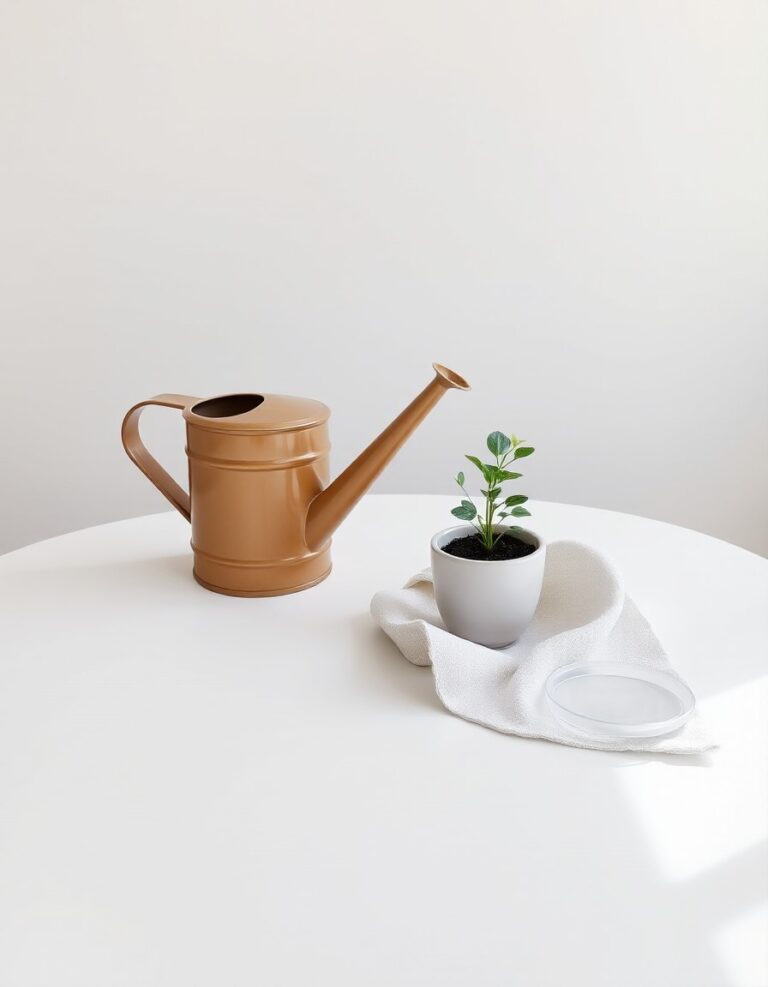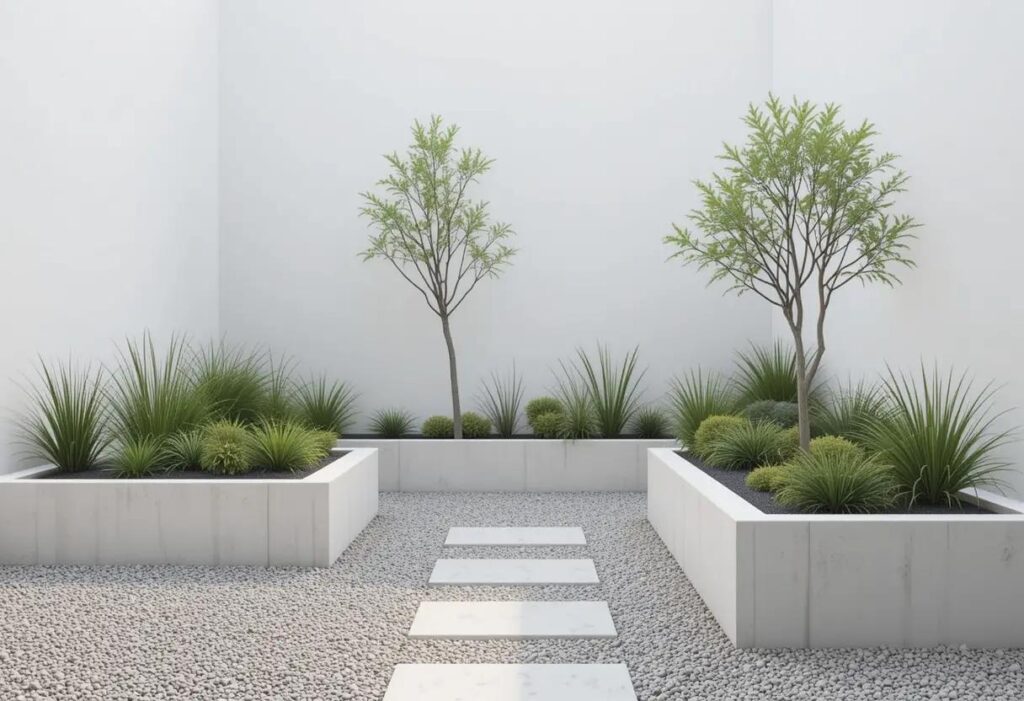
Creating a minimalist garden doesn’t mean sacrificing beauty or functionality. This design approach focuses on clean lines, purposeful plant selections, and thoughtful spatial arrangements that reduce maintenance while maximizing visual impact.
Modern homeowners increasingly turn to minimalist garden design to combat the overwhelming nature of busy schedules and cluttered living spaces. These streamlined outdoor areas offer practical benefits including reduced maintenance requirements, lower water consumption, and cost-effective upkeep while delivering sophisticated aesthetic appeal.
Understanding Minimalist Garden Design Principles
Minimalist garden design centers on three core concepts: simplicity, functionality, and intentional plant placement. This approach eliminates unnecessary elements while emphasizing quality materials, geometric shapes, and strategic use of negative space.
Key characteristics include limited color palettes, clean architectural lines, and carefully curated plant selections. Rather than filling every available space, minimalist gardens celebrate empty areas as essential design elements that allow featured components to shine.
15 Minimalist Garden Ideas
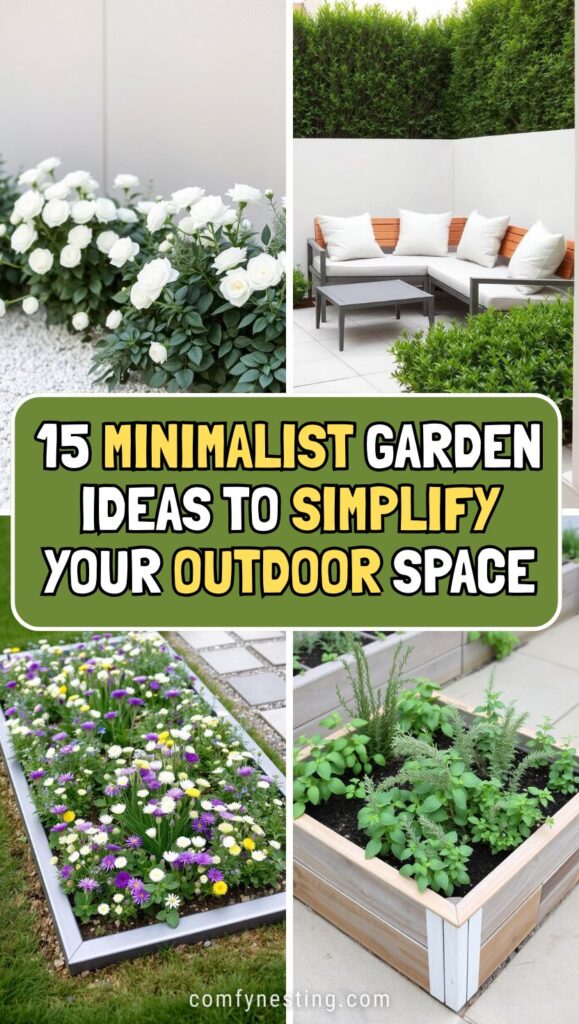
1. Monochrome Planting
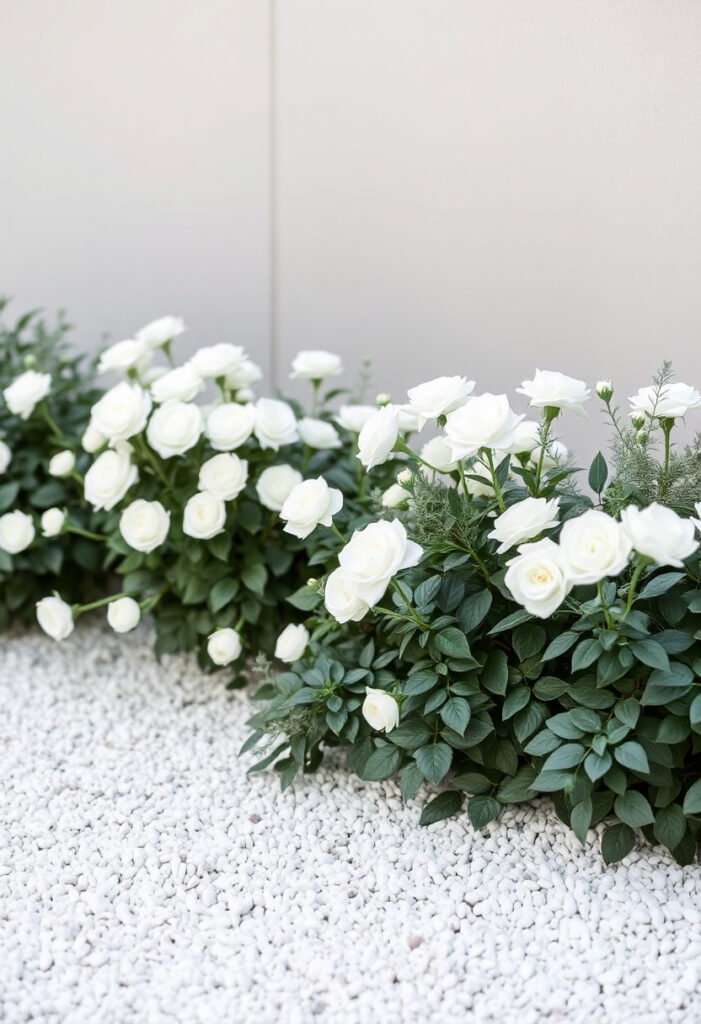
Monochrome planting schemes create instant visual cohesion by limiting color variations to single hues or complementary tones. White gardens featuring hostas, white roses, and silver-leafed plants establish a serene, sophisticated atmosphere. Alternatively, green-only plantings using various foliage textures and shades create depth without color distraction.
This approach simplifies plant selection while ensuring year-round visual consistency. Popular monochrome combinations include all-white flowering plants, various green foliage plants, or silver and gray-toned specimens that require minimal water.
2. Gravel and Stone Pathways

Gravel pathways define movement through minimalist gardens while requiring virtually no maintenance. Choose uniform stone sizes and neutral colors like gray, beige, or white to complement surrounding plantings. These surfaces provide excellent drainage and create satisfying textural contrasts against smooth plant foliage.
Stone pathways offer similar benefits with added durability. Large format pavers or natural stone slabs create strong geometric patterns that reinforce the minimalist aesthetic while providing stable walking surfaces in all weather conditions.
3. Raised Planter Boxes
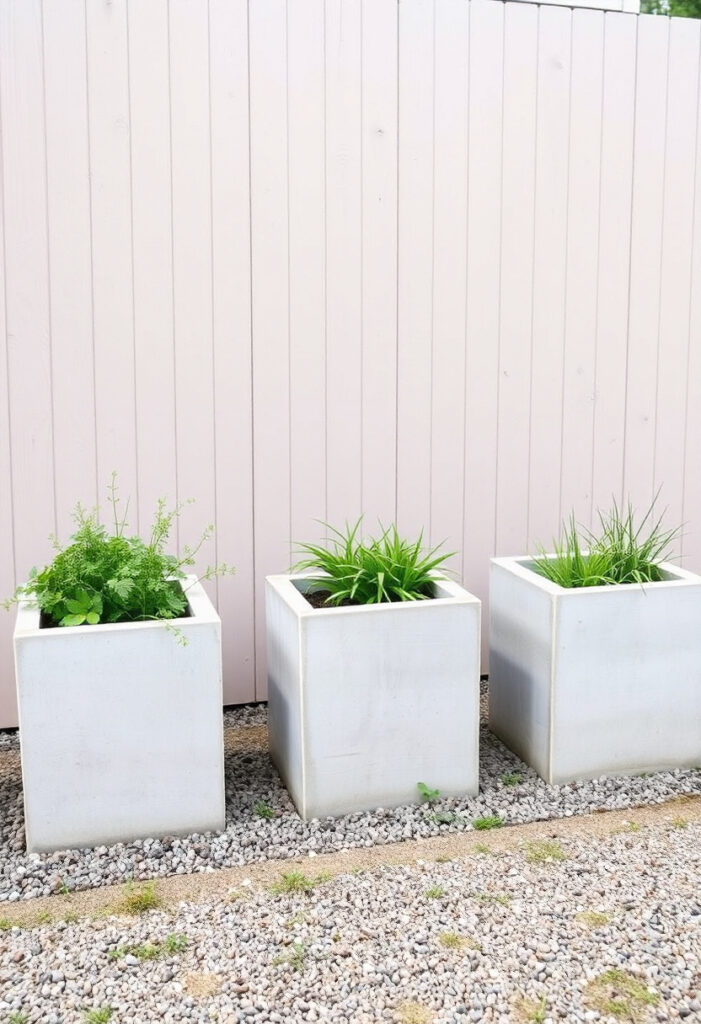
Raised planter boxes introduce architectural structure while improving soil drainage and plant health. Construct these features using materials like treated lumber, concrete blocks, or metal edging to match your home’s exterior finishes. Standardized dimensions and repeated placement create visual rhythm throughout the space.
These elevated growing areas simplify maintenance by reducing bending and kneeling during garden care. They also provide better soil control, allowing you to customize growing conditions for specific plant requirements while keeping roots contained and organized.
4. Succulent Garden
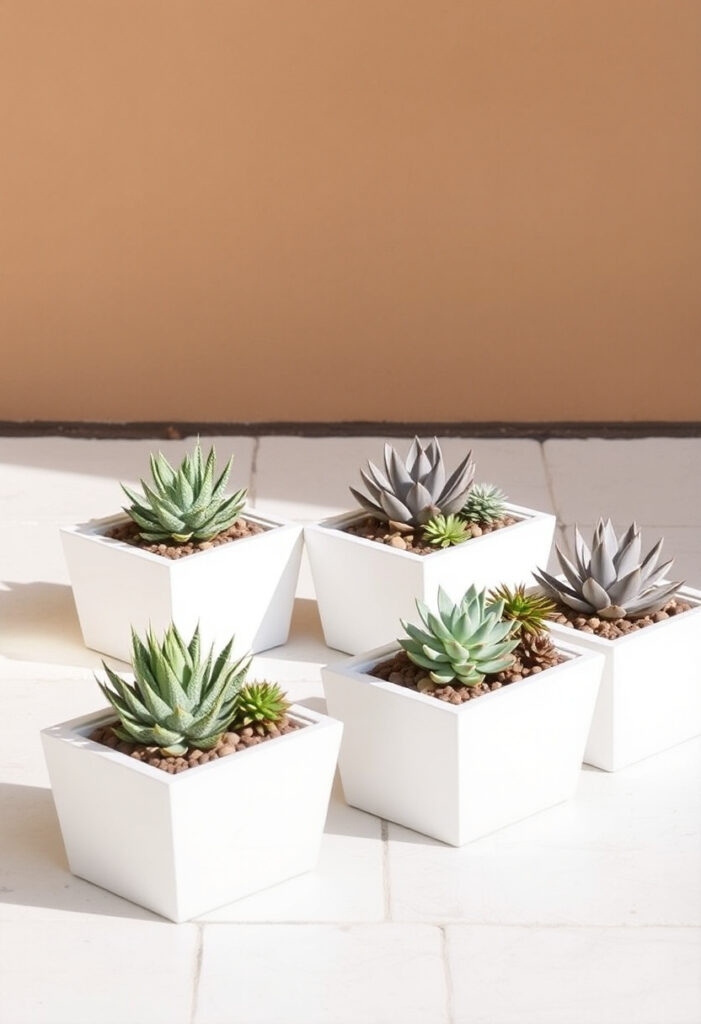
Succulent gardens reflect low-maintenance minimalist design with their sculptural forms and drought-tolerant nature. Varieties like echeveria, sedum, and agave thrive in well-draining, low-nutrient soils and require infrequent watering, making them ideal for busy homeowners. Their bold shapes and textures offer visual interest without the frequent pruning, fertilizing, or pest control typical of many flowering plants.
5. Ornamental Grass Borders
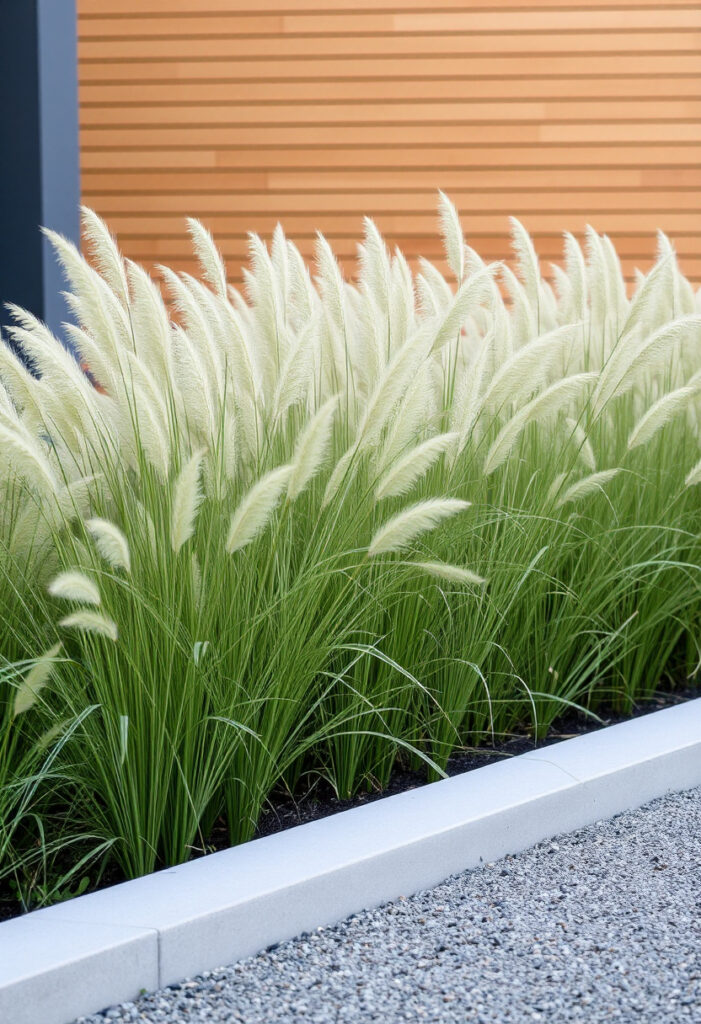
Ornamental grass plantings create movement and texture in minimalist gardens through their architectural forms and seasonal interest. Select varieties like fountain grass, feather reed grass, or miscanthus that maintain structural integrity throughout growing seasons while requiring minimal maintenance.
These grasses work exceptionally well as border plantings or mass groupings, providing natural screening and wind movement that adds dynamic elements to otherwise static garden designs. Their neutral color palettes and clean growth habits complement contemporary outdoor spaces while requiring only annual cutting back for optimal health.
6. Minimalist Outdoor Seating
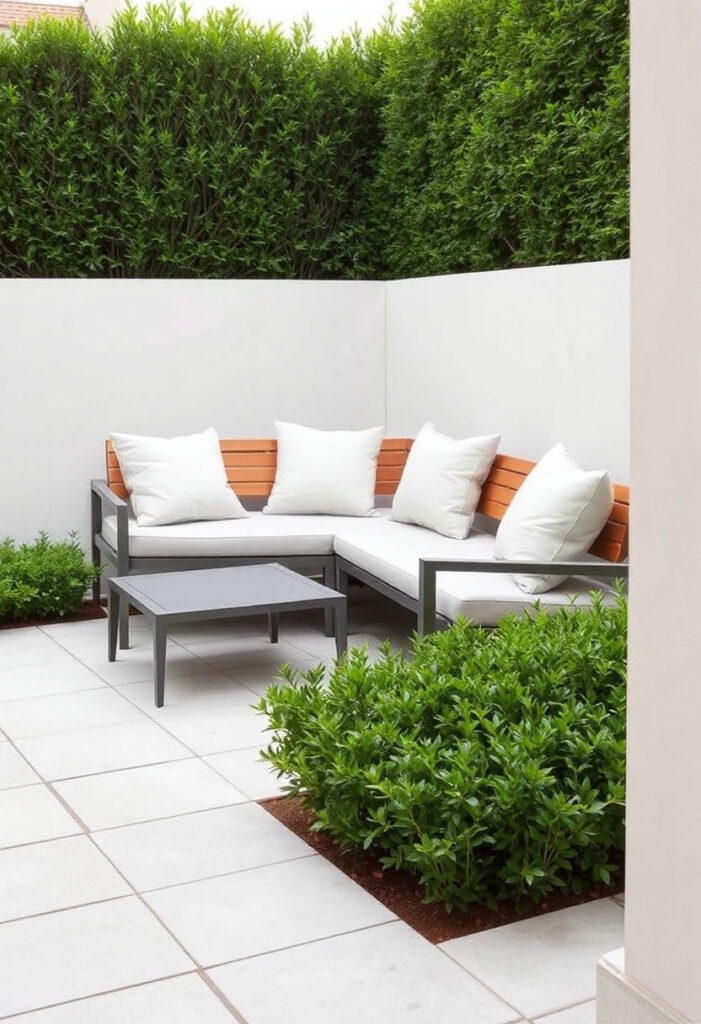
Simple outdoor seating integrates functional rest areas without overwhelming the garden’s clean aesthetic. Choose furniture with straight lines, neutral colors, and weather-resistant materials like teak, aluminum, or powder-coated steel.
Built-in seating using concrete, stone, or composite materials creates permanent solutions that blend seamlessly with hardscape elements. Position seating to take advantage of garden views while maintaining clear sightlines and uncluttered pathways.
7. Single Statement Tree
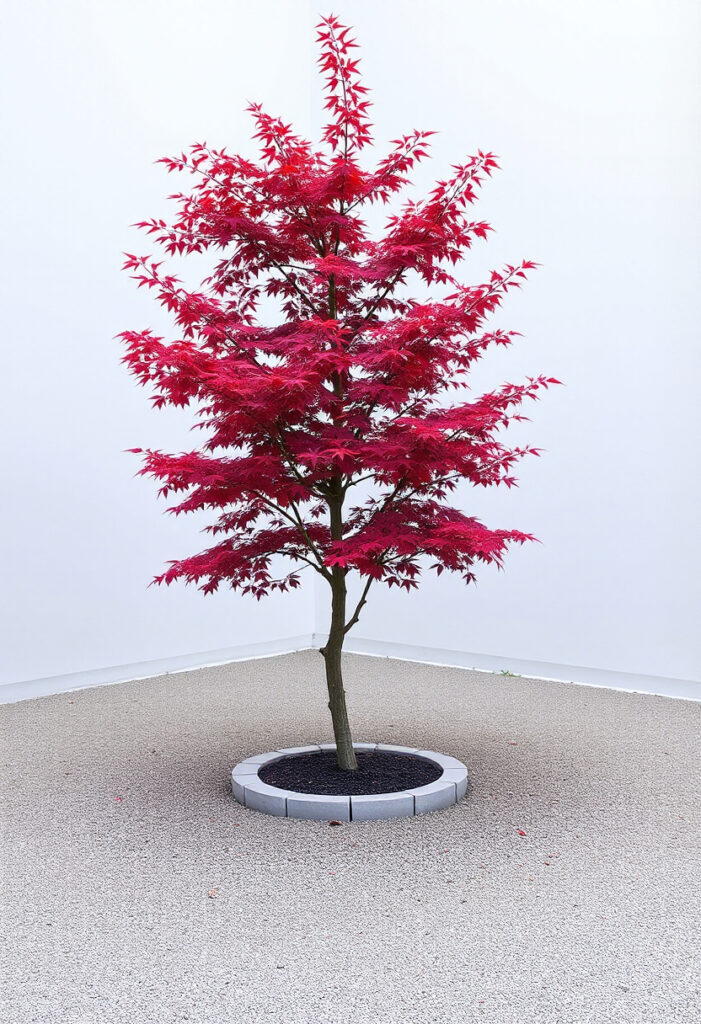
A single statement tree serves as the garden’s primary focal point while providing vertical interest and seasonal changes. Select specimens with distinctive bark, interesting branching patterns, or exceptional foliage like Japanese maples, ornamental cherries, or architectural conifers.
Proper placement ensures the tree doesn’t overwhelm surrounding elements while providing natural shade and wind protection. Underplant with simple groundcovers or leave the area open to emphasize the tree’s sculptural qualities.
8. Wildflower Patch with Defined Borders
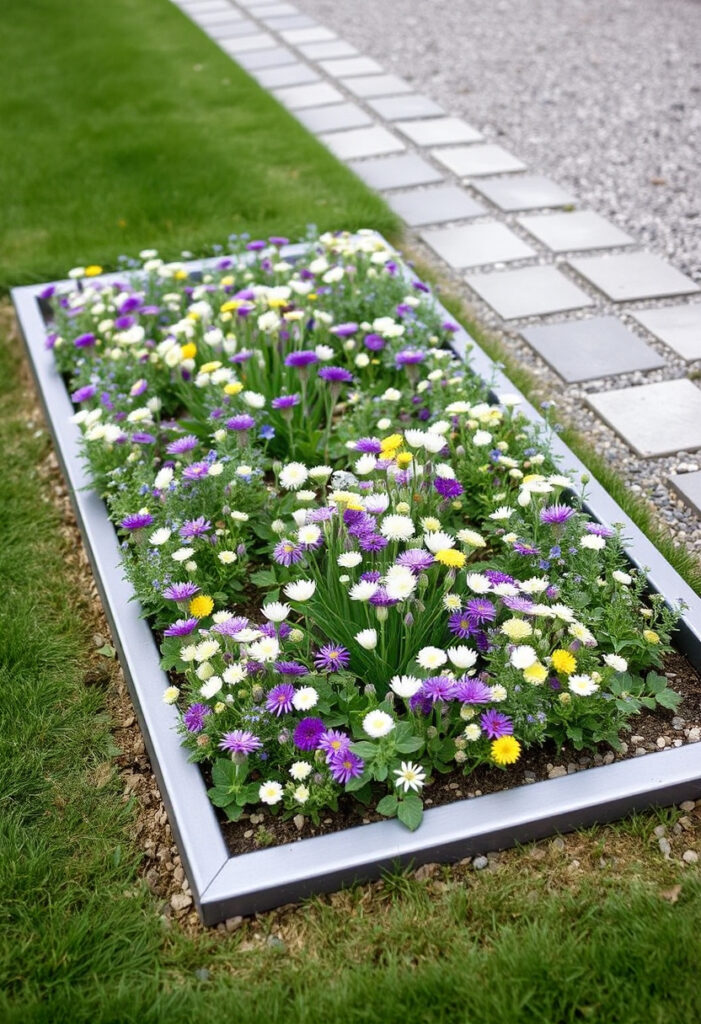
Controlled wildflower areas introduce natural movement and color while maintaining the overall minimalist framework. Establish clear boundaries using metal edging, stone borders, or mown grass strips to prevent spreading into adjacent organized areas.
Choose native wildflower mixes adapted to your climate conditions for best results with minimal intervention. These areas provide habitat for beneficial insects while requiring only annual seeding and occasional maintenance to control aggressive species.
9. Structured Lighting Design
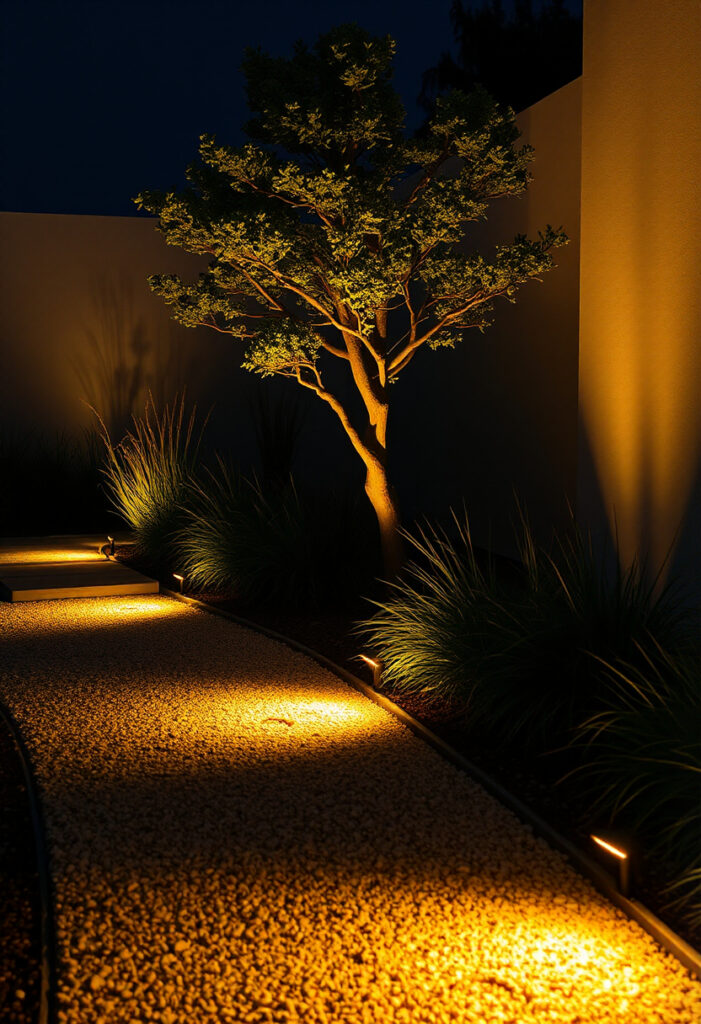
Strategic outdoor lighting extends garden usability into evening hours while highlighting key design elements through carefully placed fixtures. Use linear LED strips along pathways, uplighting for specimen trees, or geometric post lights that match the garden’s clean aesthetic.
Focus on functional illumination rather than decorative excess, choosing fixtures with simple forms and warm color temperatures. Solar-powered options reduce installation complexity while providing environmentally conscious operation. Proper lighting placement enhances safety while creating subtle evening ambiance.
10. Use Natural Mulch Instead of Grass
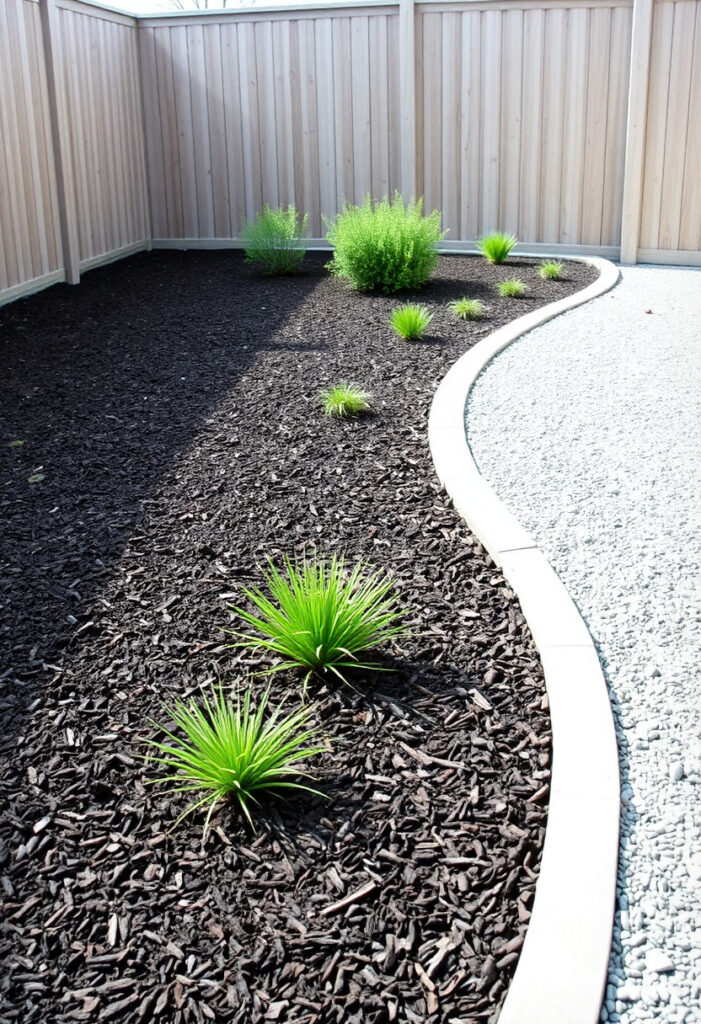
Natural mulching materials like wood chips, bark, or decomposed granite replace traditional lawn areas while reducing water requirements and maintenance tasks. These surfaces unify planted areas and create clean transitions between different garden zones.
Mulched areas require periodic refreshing but eliminate mowing, fertilizing, and irrigation needs associated with turf grass. Choose materials that complement your home’s color scheme and existing hardscape elements for visual consistency.
11. Simple Box Hedging

Low-maintenance hedging using plants like boxwood, privet, or dwarf conifers creates clean boundaries and geometric shapes without requiring frequent trimming. These plants respond well to pruning and maintain compact forms with minimal intervention.
Establish hedging in straight lines or simple geometric patterns to reinforce the minimalist aesthetic. Regular but infrequent trimming keeps these plants neat while their evergreen nature provides year-round structure and color.
12. Minimalist Herb Garden
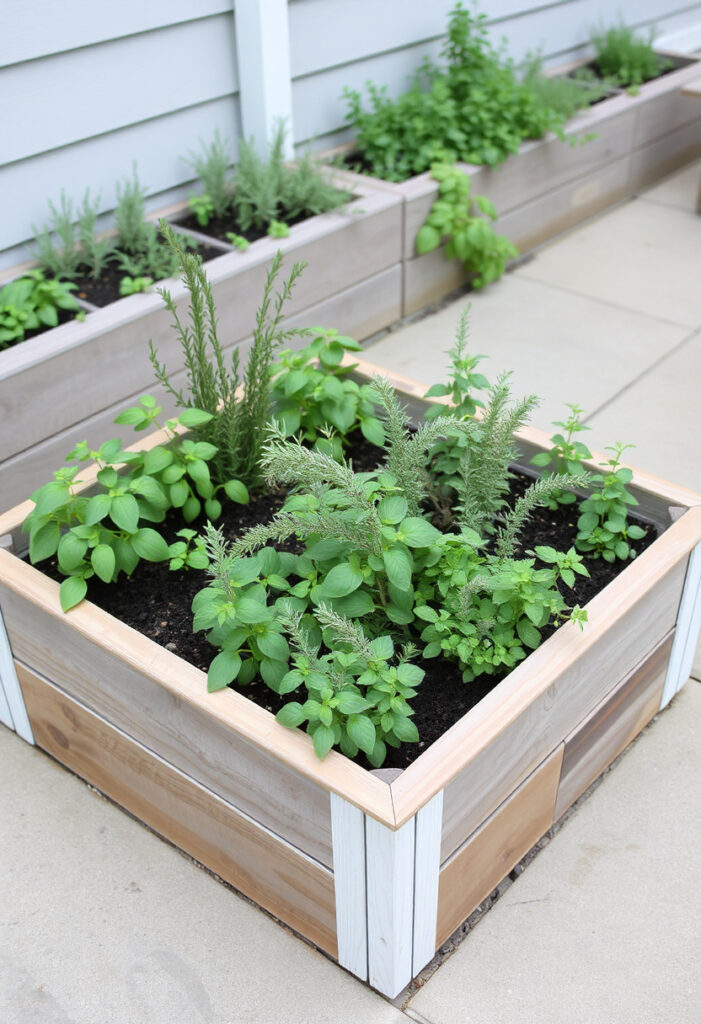
A functional herb garden combines practical growing with minimalist design principles through organized planting arrangements and purposeful plant selection. Group culinary herbs like basil, rosemary, and thyme in geometric patterns using raised beds or container arrangements.
This approach provides fresh ingredients for cooking while maintaining visual organization. Many herbs offer attractive foliage, pleasant fragrances, and beneficial insect attraction while requiring minimal care once established in appropriate growing conditions.
13. Large Leaf Plants as Focal Points
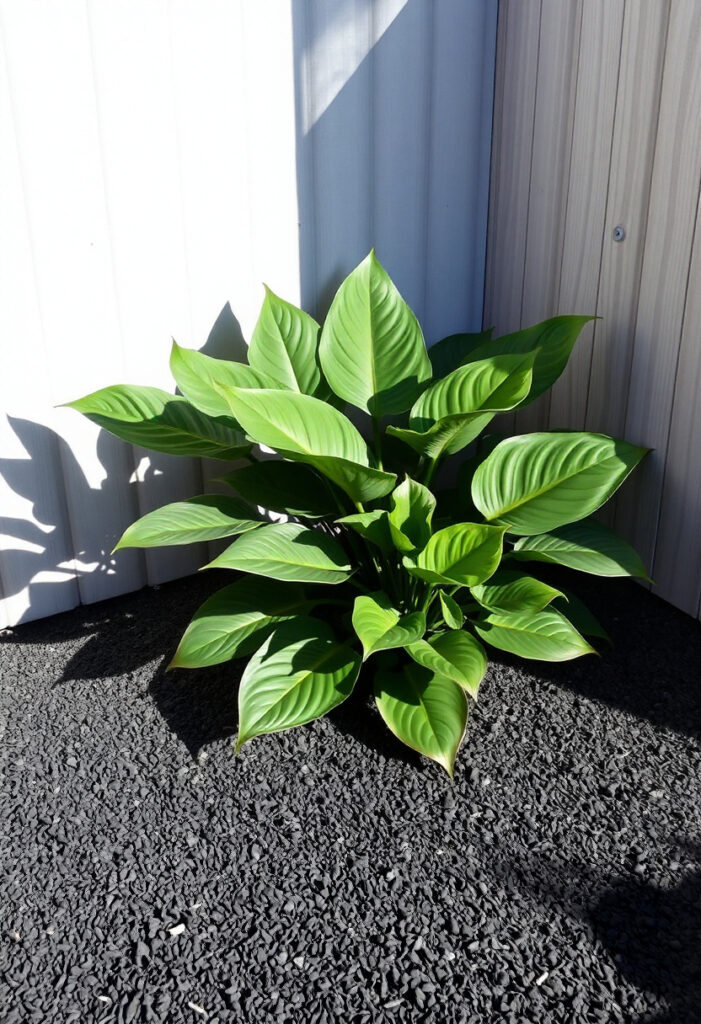
Bold foliage plants like hostas, ferns, or tropical specimens create dramatic focal points through their substantial leaf size and distinctive textures. These plants work particularly well in shaded areas where flowering options may be limited.
Select varieties appropriate for your climate conditions and group in odd numbers for natural-looking arrangements. Their substantial presence reduces the need for multiple smaller plants while providing season-long visual interest through foliage alone.
14. Concrete Planters in Geometric Shapes
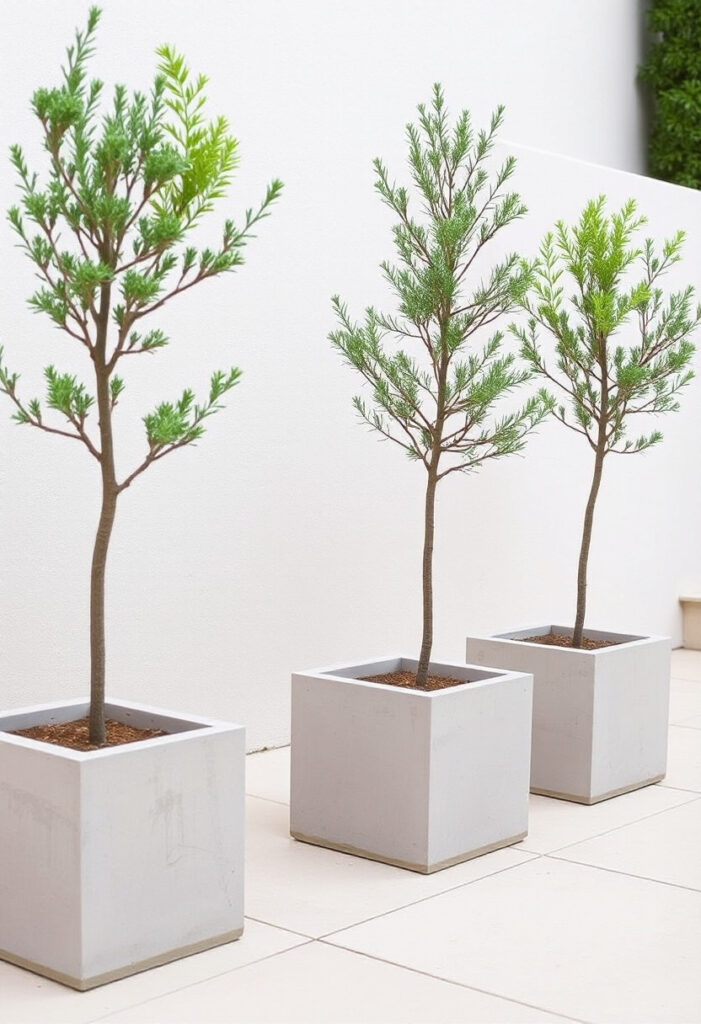
Geometric concrete planters introduce contemporary styling while providing excellent growing conditions for contained plantings. Square, rectangular, and cylindrical forms reinforce minimalist design principles while accommodating various plant sizes and root requirements.
These durable containers withstand weather extremes and maintain consistent appearance over time. Group planters in balanced arrangements using the same plant varieties for each container to create cohesive visual statements throughout the outdoor space.
15. Use Modular Planters

Modular planting systems offer flexibility for changing arrangements while maintaining design consistency through standardized sizing and materials. These systems allow seasonal adjustments and experimental layouts without permanent installations.
Components can be rearranged based on plant growth, seasonal changes, or evolving design preferences. This adaptability makes modular systems particularly valuable for renters or homeowners who enjoy periodic garden updates without major renovations.
Implementation Tips for Your Minimalist Garden
Start with a master plan that identifies key areas for seating, pathways, and major plantings before making permanent installations. This planning phase prevents costly mistakes and ensures all elements work together cohesively.
Choose quality materials that will maintain their appearance over time rather than budget options requiring frequent replacement. Durable materials justify higher initial costs through reduced long-term maintenance and replacement expenses.
Focus on soil preparation before planting to ensure healthy plant establishment and reduced ongoing care requirements. Well-prepared growing conditions prevent many common plant problems while supporting vigorous growth with minimal intervention.
Maintenance Benefits of Minimalist Garden Design
Reduced time commitments represent one of the primary advantages of minimalist garden approaches. Simplified plant palettes, quality hardscape materials, and purposeful design choices minimize routine maintenance tasks while preserving visual appeal.
Water conservation becomes natural when drought-tolerant plants and efficient irrigation systems replace water-hungry traditional landscaping elements. These choices reduce utility costs while supporting environmental sustainability goals.
Year-round interest develops through careful selection of evergreen plants, architectural hardscape elements, and seasonal focal points that maintain visual appeal regardless of weather conditions or dormant periods.
Questions & Answers About Minimalist Garden
Q: How much does it cost to create a minimalist garden? A: Minimalist garden costs vary significantly based on size, materials, and plant selections. Basic projects using gravel pathways and simple plantings can cost $1,000-3,000 for small spaces, while comprehensive designs with quality hardscaping may range from $5,000-15,000. The investment often pays for itself through reduced maintenance costs and increased property value.
Q: What plants work best in minimalist gardens? A: The best plants for minimalist gardens include evergreen shrubs, ornamental grasses, succulents, and specimens with distinctive foliage or architectural forms. Popular choices include boxwood, lavender, ornamental grasses like miscanthus, hostas, and drought-tolerant perennials. Choose plants that maintain attractive appearance with minimal pruning and care.
Q: How do I maintain a minimalist garden? A: Minimalist garden maintenance focuses on periodic tasks rather than constant upkeep. Key activities include seasonal pruning of shrubs, annual mulch refreshing, occasional weeding, and plant replacement as needed. Most minimalist gardens require 2-4 hours of maintenance per month compared to 8-12 hours for traditional landscapes.
Q: Can minimalist gardens work in small spaces? A: Minimalist design principles work exceptionally well in small spaces by maximizing visual impact while minimizing clutter. Vertical growing systems, container plantings, and multi-functional elements help small areas feel larger and more organized. Focus on quality over quantity when selecting plants and materials for compact spaces.
Q: How do I choose the right color scheme for a minimalist garden? A: Successful minimalist color schemes typically limit palettes to 2-3 colors maximum. Popular approaches include monochromatic green schemes using various foliage plants, neutral combinations of white, gray, and green, or single accent colors against predominantly green backgrounds. Test color combinations in small areas before committing to larger installations.

